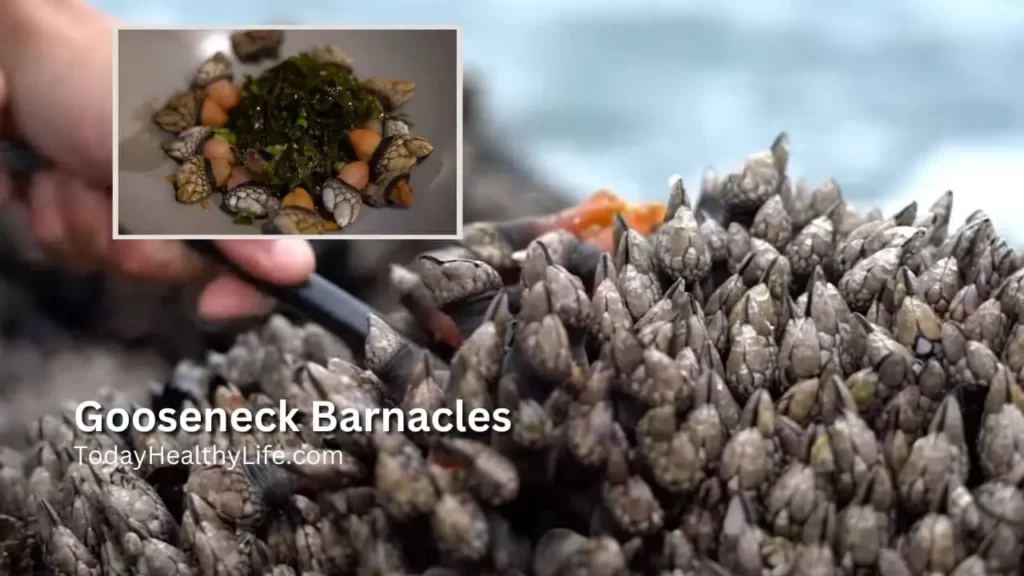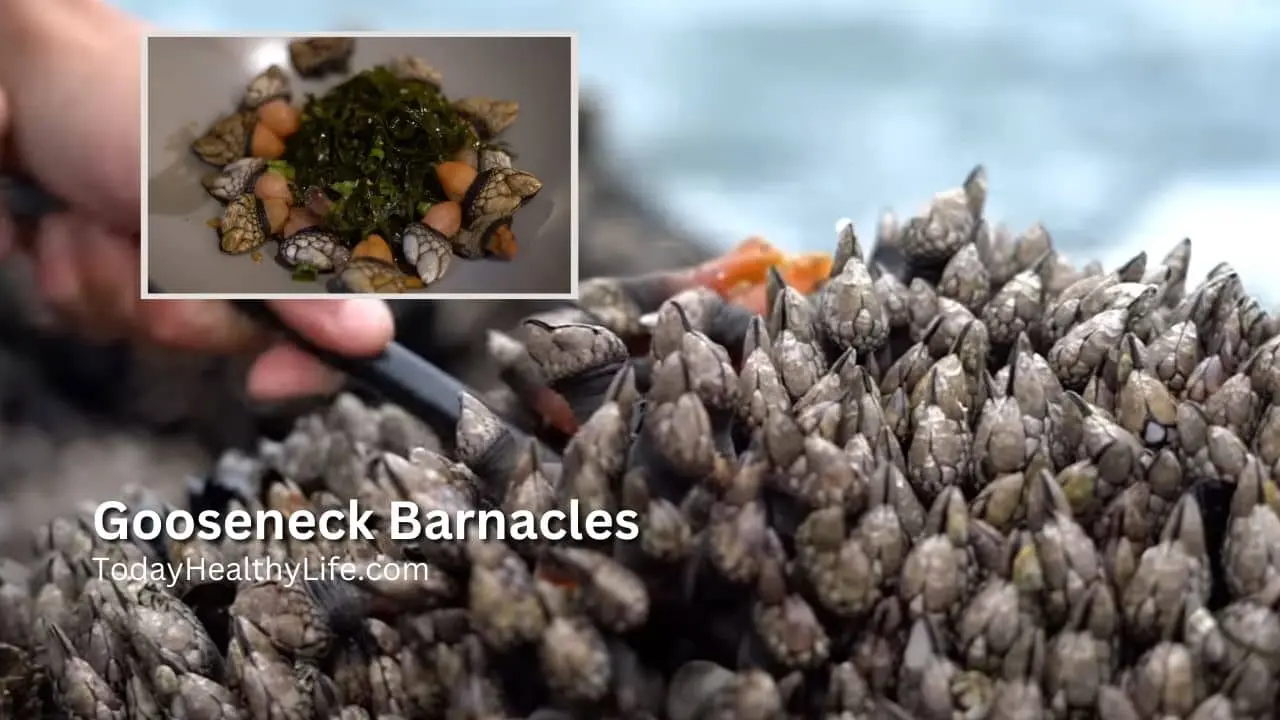Do you know that gooseneck barnacles are a delicacy in Europe? These small crustaceans have a variety of benefits, including being a good source of protein and omega-3 fatty acids.
However, there are also some potential side effects to consider before eating them.
In this blog post, we’ll take a closer look at the nutritional value and other features of gooseneck barnacles.
So whether you’re looking for an interesting new food to try or just want to learn more about these creatures, read on!

Also Read:
- Gooseneck Barnacles Recipe, Or How To Eat Goose Barnacle?
- Why Are Gooseneck Barnacles Dangerous? – Resistance Way & All.
Table of Contents
What are Gooseneck Barnacles?
Gooseneck barnacles are a type of crustacean that is commonly found clinging to rocks and coastline.
This seafood is also known as percebes in Spanish, pilgrim’s-foot in English, and bécune in French.
These strange-looking creatures have long, curved necks that they use to filter food from the water.
Gooseneck barnacles are often considered a nuisance because they can attach themselves to boats and other structures.
However, they are also an important food source for many animals, including whales, seabirds, and fish. In addition, gooseneck barnacles play an important role in the ecosystem by providing homes for other marine creatures.
For example, it is not unusual to find small crabs and shrimp living among the barnacles. Therefore, although they may be considered pests by some, gooseneck barnacles are actually an important part of the marine environment.
What to do with Gooseneck Barnacles?
Gooseneck barnacles can be eaten both cooked and raw. In Europe, they are often boiled or steamed before being eaten as a delicacy.
Some people even compare their taste and texture to lobster or shrimp. In addition to eating them whole, gooseneck barnacles can also be used as an ingredient in dishes such as paella or risotto.
Nutrition value
One serving (100 grams) of gooseneck barnacles provides approximately:
| Nutrient | Amount |
|---|---|
| Calories | 66 |
| Protein | 15.7 grams |
| Fat | 0.4 grams |
| Carbohydrates | 0 grams |
| Fiber | 0 grams |
| Sugar | 0 grams |
| Sodium | 100 milligrams |
| Potassium | 240 milligrams |
| Calcium | 130 milligrams |
| Iron | 1.3 milligrams |
| Magnesium | 20 milligrams |
| Selenium | 73 micrograms |
As you can see, gooseneck barnacles are a very low-calorie food that is high in protein and minerals.
They are a good source of iodine, selenium, and iron, which are all important nutrients for human health.
Benefits of Gooseneck Barnacles
Gooseneck barnacles are a type of shellfish that is native to the Atlantic and Pacific oceans.
They are considered a delicacy in many countries, including Spain, Portugal, and France.
In addition to their delicious taste, gooseneck barnacles also offer a number of health benefits. They are a good source of protein, iodine, selenium, and iron.
These nutrients are important for a variety of bodily functions, including:
- Immunity: Iodine is essential for the production of thyroid hormones, which play a role in the immune system.
- Thyroid function: Selenium is also important for thyroid function.
- Cell protection: Selenium helps to protect cells from damage.
- Bone health: Iodine and calcium are important for bone health.
- Blood sugar regulation: Iron helps to regulate blood sugar levels.
Gooseneck barnacles are also a low-calorie food, making them a good choice for people who are trying to lose weight or maintain a healthy weight.
If you are looking for a healthy and delicious seafood option, gooseneck barnacles are a great choice.
They are a good source of protein and important nutrients, and they are low in calories.
Here are some of the specific health benefits of gooseneck barnacles:
- Boosting the immune system: Iodine is essential for the production of thyroid hormones, which play a role in the immune system. Selenium also helps to protect cells from damage, which can help to boost the immune system.
- Improving thyroid function: Iodine is essential for the production of thyroid hormones, which play a role in many bodily functions, including metabolism, growth, and development. Selenium also helps to support thyroid function.
- Protecting cells from damage: Selenium helps to protect cells from damage, which can help to reduce the risk of cancer and other chronic diseases.
- Improving bone health: Iodine and calcium are important for bone health. Iodine helps to regulate the production of thyroid hormones, which are essential for bone growth and development. Calcium is the main mineral in bones, and it helps to keep bones strong and healthy.
- Regulating blood sugar levels: Iron helps to regulate blood sugar levels. This is important for people with diabetes or those who are at risk for developing diabetes.
Overall, gooseneck barnacles are a healthy and delicious seafood option that offers a number of health benefits.
If you are looking for a way to boost your immune system, improve your thyroid function, protect your cells from damage, improve your bone health, or regulate your blood sugar levels, gooseneck barnacles are a great choice.
Gooseneck Barnacles taste
Gooseneck barnacles have a sweet, delicate flavor that has been described as a cross between lobster and clam.
They have a chewy texture that is similar to squid. The taste of gooseneck barnacles can vary depending on the region where they are harvested and how they are prepared.
In Spain and Portugal, gooseneck barnacles are typically steamed or grilled and served with a simple vinaigrette. In France, they are often served with butter or aioli.
Here are some of the most common descriptions of the taste of gooseneck barnacles:
- Sweet: Gooseneck barnacles have a mild, sweet flavor that is often compared to lobster or clams.
- Chewy: The texture of gooseneck barnacles is chewy, similar to squid or octopus.
- Delicate: The flavor of gooseneck barnacles is delicate and not overpowering.
- Creamy: The flesh of gooseneck barnacles is creamy and slightly milky.
- Umami: Gooseneck barnacles have a mild umami flavor, which is a savory, meaty taste.
If you are looking for a unique and delicious seafood experience, gooseneck barnacles are a great option.
They have a sweet, delicate flavor with a chewy texture that is sure to please seafood lovers.
Also Read:
What to eat
Gooseneck barnacles can be eaten whole, including the legs and shell, but some people prefer to only eat the fleshy parts. The legs can also be used for stock or broth.
Many people enjoy gooseneck barnacles boiled or steamed, with a squeeze of lemon or served with garlic butter. They can also be grilled, baked, fried, or added to dishes such as paella or risotto.
Side effects & considerations
Some people may experience allergic reactions when eating gooseneck barnacles. It’s also important to note that these crustaceans can accumulate toxins from their environment, so it’s important to ensure they are harvested from clean waters.
Additionally, gooseneck barnacles have a high sodium content, so they should be eaten in moderation if you have high blood pressure or other related health concerns.
Please consult with a healthcare professional before incorporating this seafood into your diet.
Some FAQs:
Yes, they can be eaten raw like sashimi or ceviche. However, they are often boiled or steamed before eating.
Gooseneck barnacles can be found in seafood markets and some specialty grocery stores. They may also be available online.
Gooseneck barnacles are considered a sustainable seafood choice as their populations and habitats are stable. However, it’s important to ensure they are harvested from clean waters to avoid any potential toxin accumulation.
Once the hard outer shell is removed, gooseneck barnacles can be cooked in a variety of ways including boiling, steaming, grilling, and sautéing. They can also be used as an ingredient in dishes like paella or risotto.
Gooseneck barnacles are typically harvested during the summer months. However, they can be found year-round in markets as they are often frozen or canned.
No, gooseneck barnacles and goose barnacles (also known as rock barnacles) are not related. They belong to different species and have different appearances and taste profiles.
Goose barnacles are typically larger and have a stronger, more fishy flavor compared to gooseneck barnacles.
Gooseneck barnacles do not typically have high levels of mercury. They are considered a low-mercury seafood choice.
However, as with all seafood, it’s important to consume in moderation and vary your seafood choices.
Consult with a healthcare professional if you have concerns about mercury levels in seafood.
Gooseneck barnacles are a source of protein, vitamins, and minerals including iron, zinc, and calcium.
They also contain omega-3 fatty acids that may provide health benefits such as improved heart health. However, they are high in sodium so should be consumed in moderation.
It’s also important to note that gooseneck barnacles can accumulate toxins from their environment, so it’s important to ensure they are harvested from clean waters.
Consult with a healthcare professional before incorporating this seafood into your diet.
Conclusion:
Barnacles are a great source of protein and other nutrients, making them a healthy food choice. They also have some surprising benefits that you may not know about.
If you’re looking for a new type of seafood to try, gooseneck barnacles should definitely be at the top of your list!
However, it’s important to ensure they are harvested from clean waters and consumed in moderation due to their high sodium content.
Consult with a healthcare professional before incorporating this seafood into your diet. Happy eating!

